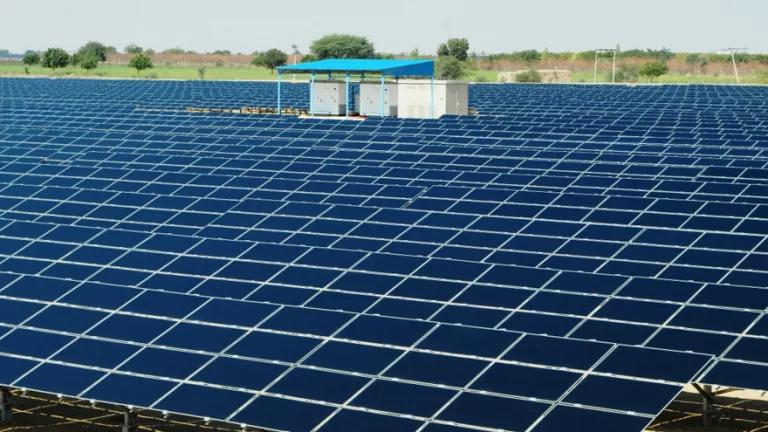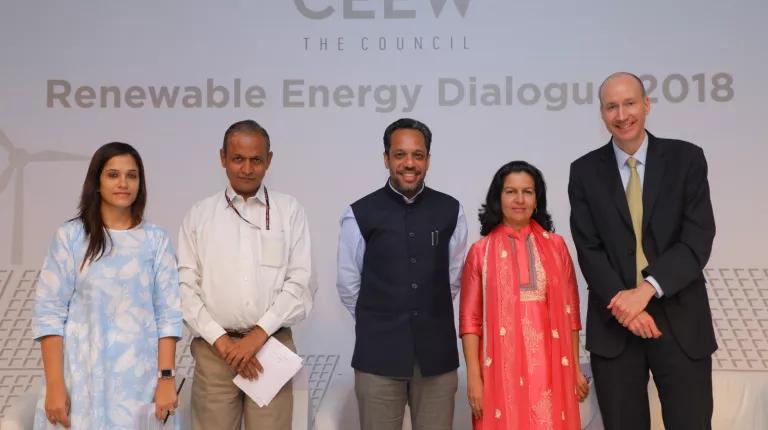
A large photovoltaic solar panel array on Kiran Energy’s 20 megawatt solar plant in Jodhpur, Rajasthan, India
NRDC
Guest Blog by Poonam Sandhu and Madhura Joshi
In this summer’s Renewable Energy Dialogue in Delhi, energy leaders from across the country discussed the expanding share of renewables in the global energy mix and India’s growing role in the sector’s progress. Renewable energy makes up nearly 20% of India’s installed electricity capacity, constituting the second largest share of the country’s electricity basket as of March 2018. Renewable energy has more than quadrupled in India from around 16 GW in 2010 to over 70 GW in 2018. Globally, a record 157 GW of renewable energy was commissioned in 2017.
While these developments are encouraging, the International Energy Agency’s “Energy Technology Perspectives 2017” report urges that to meet Paris Agreement commitments, renewable energy needs to develop at a much faster pace—and faster still to limit global temperature rise to below 1.5oC. But such rapid development in the renewables market will require assured steady sources of financing, a major topic of discussion during the REDialogue.
India’s Climate and Energy Goals
For India, the success of the renewable energy sector will be crucial to meet its Nationally Determined Commitments (NDC) under the Paris Agreement and its transition towards a sustainable future. In its NDCs, India has committed to reducing its greenhouse gas emissions intensity by 33 to 35% below 2005 levels by 2030, and to achieving 40% of its installed electric power capacity from non-fossil sources by the same year. Simultaneously, India has set an ambitious domestic target of 175 GW of renewable energy by 2022, and the recent National Electricity Plan 2018 reaffirms further expansion to 275 GW by 2027.
Solar energy is at the heart of both targets. Accelerating renewables deployment will work to achieve multiple goals of economic development, job creation, domestic manufacturing, energy access and security, improved air quality, and reduced climate pollution. However, achieving these targets is not easy; and the sector faces several technological, policy, regulatory, and financial challenges.
India’s Renewable Energy Dialogue
To meet India’s renewable energy ambitions, understanding the financing requirements of the sector and expanding access to finance for renewable energy developers and manufacturers will be critical. Expanded access to financing was a major theme during the Renewable Energy Dialogue organized by the Council on Energy, Environment and Water (CEEW) on June 29, 2018. The dialogue focused on unpacking the opportunities, risks, and challenges faced in advancing the renewable energy sector and finding solutions.
The Renewable Energy Dialogue is an annual event which aims to bring together multiple national and international stakeholders, such as renewable energy developers, manufacturers, financiers, policy makers, regulators, lawyers, and policy researchers. Minister Suresh Prabhu, India’s Minister of Commerce and Industry, gave passionate keynote on the need to accelerate renewables to increase energy access.
Financing Growth in India’s Renewables Sector

Building on Minister Prabhu’s speech, NRDC India Program’s Poonam Sandhu also highlighted potential breakthroughs in accelerating clean energy through catalytic finance during the “Risks in Renewable Energy Markets in Emerging Economies” panel. One of the discussion points highlighted that distributed renewable energy projects face some of the classic problems of financing small projects that are compounded by new technologies and business models. For example, rooftop solar loans are usually small ticket loans of mostly unrated borrowers from small– to medium-sized enterprises for relatively untested business models backed by new technologies. This segment, therefore, faces challenges in attracting interest from mainstream lenders.
A possible solution is for renewable energy lenders to bundle such small loans from diverse geographies, demonstrate some loan performance, or provide credit enhancements. This will make the investments into “underserved segments” attractive for a larger set of investors. International investors have also expressed interest in investing in renewable energy projects in India and other emerging economies. These investors include multilateral and other donors who can provide low-cost capital that can be “catalytic” and help leverage commercial capital into the renewable energy market.
International investors, however, have certain requirements which need to be addressed to attract these funds. Such investors look to route their investments through financial institutions that have expertise in renewable energy financing. In addition, they prefer financial institutions with capacities to assess renewable energy business models and market trends, and ability to craft financial products to suit the needs of the sector. However, they are also concerned about the possibility of “green washing” investments. Hence, the application of “green finance principles” while lending by domestic financial institutions that understand the market can enhance investor confidence. This underscores the need for a specialized green institution or a “green window” within existing financial institutions to attract the vast amount of capital required to finance renewable energy projects and to help meet clean energy targets.
A key consensus from the dialogue was that the risks in the renewable energy market are significant but, not insurmountable. Globally and in India, we are in the midst of an energy transition. This requires a comprehensive approach to the sector rather than an energy silo-based one. Simultaneously, more focus is needed on underserved market segments (such as distributed renewable energy and solar rooftops) and applications of renewable energy in sectors other than electricity generation (such as in transport and heat-removal).
Accelerating sustainable energy transitions and de-risking its financing requires data availability, enhanced capacity of different stakeholders, and importantly, an enabling policy environment. Specialized facilities, such as green institutions and windows, can play a key role in advancing capacity and financing in the renewable energy sector with expert green finance teams to achieve India’s climate and clean energy targets.


